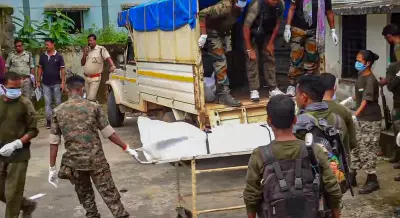Politics
3 Naxalites, Including Woman, Killed in Sukma Encounter with Security Forces
A woman among three Naxalites was killed in an encounter with security forces in Chhattisgarh's Sukma district on December 18. Police confirm the operation was based on specific intelligence.
Business
CAG Flags 38% Staff Shortage in CBIC Audit, GST Compliance at Risk
CAG report reveals a 38% staffing shortage in CBIC audit wings, leading to a gap between planned and completed GST audits. Recovery rates remain low. Ministry urged to fill vacancies.
World
Cessna C550 Crashes at North Carolina Airport, Fireball Seen on Video
A Cessna C550 business jet crashed while landing at Statesville Regional Airport, North Carolina. FAA is investigating. Details on casualties and cause awaited.
Entertainment
Dhurandhar's Climax Decoded: Ranveer Singh, Akshaye Khanna & the 'Et Tu Brutus' Moment
Aditya Dhar reveals why 'Dhurandhar' is split into 8 parts and the meaning behind the powerful 'Et Tu Brutus' climax scene with Ranveer Singh and Akshaye Khanna. Exclusive details inside.
Sports
Lifestyle
Health
Dipika Kakar breaks down during first PET scan post-surgery
Dipika Kakar gets emotional during her first PET scan after liver cancer surgery. The actress shares her painful journey and thanks husband Shoaib for his unwavering support. Read her full story here.
Fresh Admission Round for 90 Medical, Dental Seats in Gujarat
Gujarat's admission committee announces a new round for 57 medical and 33 dental seats. Candidates must deposit Rs 3 lakh security by Dec 22. Read the full schedule here.
Festive Alert: Kids 'Crying Out' for Phone-Free Family Time
Children's Commissioner urges parents to create phone-free zones during Christmas. Half of parents plan phones at dinner table. Experts advise setting boundaries for meaningful family moments.
Polio Drive in DK: 1.4 Lakh Kids Targeted on Dec 21
Dakshina Kannada launches a major polio vaccination drive on Dec 21, targeting 1.4 lakh children under five. Door-to-door visits planned for those who miss it. Read details.
Puducherry: 221 killed in 1391 road accidents in 2024
Puducherry's 2024 road safety report reveals 1391 accidents causing 221 deaths. National highways & older vehicles pose major risks. See key findings and police action.
Technology
Get Updates
Subscribe to our newsletter to receive the latest updates in your inbox!
We hate spammers and never send spam










































